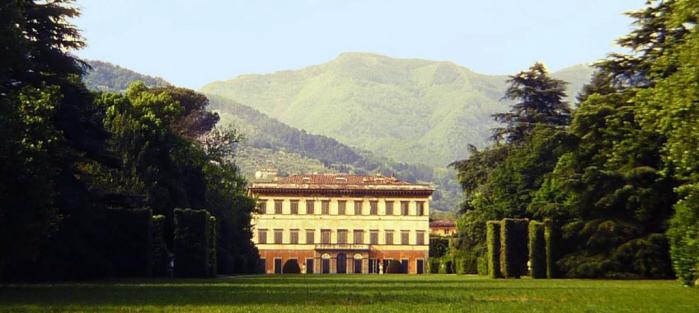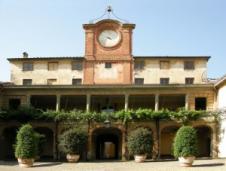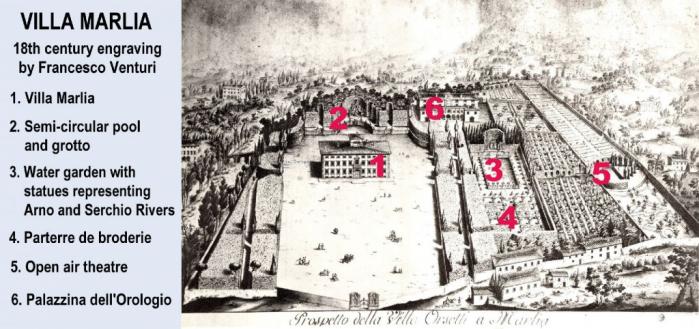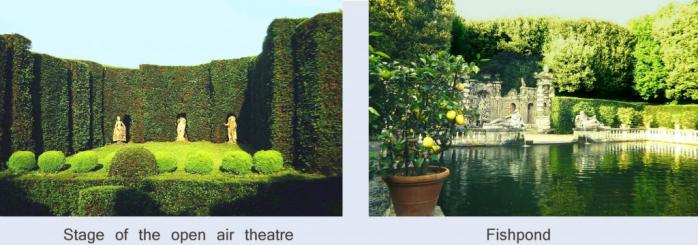Royal Villa Marlia
THE FAMOUS ROYAL VILLA MARLIA (Villa Reale di Marlia) is located to the north-east of Lucca, approximately 20 kilometres from the city centre. The term ‘Royal’ was added to the name when the villa became the official residence of Elisa Baciocchi Bonaparte.
HISTORY. The earliest records of the Royal Villa Marlia date back to 1517, when the Buonvisi family purchased the property from the Avvocati family. In 1651 the Buonvisi sold the property to Oliviero and Lelio Orsetti. The new owners remodelled the villa and created a Baroque garden with an open-air theatre, fishpond, lemon garden, nymphaeum, statues and Parterres de Broderie. The Orsettis also built the Palazzina dell’Orologio or ‘Clockhouse’. This building has a loggia over the doorway, with a raised section above containing the clock that gives the palazzina its name.
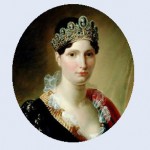
Elisa Baciocchi Bonaparte
In 1806, the property was purchased by Elisa Baciocchi Bonaparte, sister of Napoleon and princess of Lucca and Piombino. Elisa extended the estate by purchasing Villa del Vescovo and adjoining lands. She ‘modernised’ the villa in the fashionable style of the day — adding a portico in stiff Neo-classical style to the north facade and raising the top storey. The interior was redecorated by Theodore Bienaime while Stefano Tofanelli painted frescos in various rooms.
The villa became Elisa’s favourite residence and she held receptions on a grand scale. There were theatricals while Paganini, who she had appointed as her musical director, played in the park. Paganini recorded that Elisa fainted when he played his thrilling cadenzas. But the story goes that Elisa’s seductive Grand Equerry, Bartolomeo Cenami (nicknamed her ‘cher ami’), was usually in attendance to revive her.
In 1814, the Royal Villa Marlia passed to Marie Louise of Bourbon, who commissioned Lorenzo Nottolini to build an observatory ‘The Specola’ on the property. In 1923 the estate was purchased by the Count and Countess Pecci Blunt, who restored the villa and the garden to their former splendour.
THE GARDEN. On acquiring the property, Princess Elisa commissioned the French architect Morel to modernise and enlarge the garden. Vast sums were spent on waterworks. In the process attractive features of the original garden were destroyed, including the removal of the Parterres de Broderie. The result was that the character of the 17th century Baroque garden changed for the worse. The new layout was designed with asymmetrical groups of trees and lawns, creating natural vistas, a typical feature of the English-style garden.
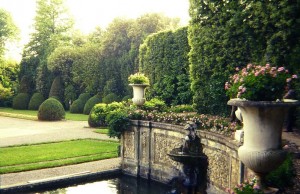
Corner of semi-circular water garden
Fortunately, the layout and charm of the upper portion of the gardens was retained. The so called ‘Water Theatre’, a semicircular pond, bordered by statues, urns and water spouts, is one of the most attractive features. So is the open-air theatre with its exidra of tall clipped yew trees and terracotta figures of Columbine, Harlequin and Pulcinella at the back of the stage. Another highlight is the water garden with a large rectangular fishpond and lemon trees in big terracotta pots on a low balustrade around the pond. Statues, representing the Arno and Serchio Rivers, face the fishpond.
Address is: Villa Reale Marlia, Via Fraga Alta 2, 55012 Capannori Lucca, Italy.
Opening time (garden only): from March to November (from December to February only upon request). Guided tours leaving on the hour between 10.00 a.m. and 6.00p.m. (closed on Mondays).

